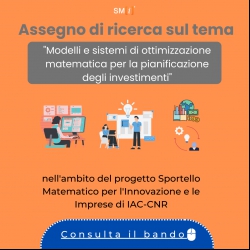
Fokker-Planck Equations for Wealth Distribution Dynamics
2016-04-26
Speaker: Bruce M. Boghosian (Department of Mathematics, Tufts University) martedi 26 aprile 2016, h. 11.30 IAC-CNR aula riunioni 1° piano, via dei Taurini, 19 - Roma
Today there are 62 people in the world who have as much combined wealth as half the human population. In 2010, that figure was 388, so it has dropped by a factor of more than six in six years. These figures make clear that wealth distributions are dynamic and that wealth is concentrating. Understanding how and why this is happening, and what if anything needs to be done about it is an interdisciplinary problem that will ultimately involve mathematicians, economists, political scientists, and specialists in ethics, justice, and public policy.
Asset-exchange models are mathematical models of wealth distribution that have received much attention in recent years. They model an economy by a collection of economic agents, who exchange wealth in pairwise transactions according to idealized rules. Their evolution may be described by stochastic differential equations, or by nonlinear and nonlocal Boltzmann equations [Ispolatov, Krapivsky, Redner, 1997] or Fokker-Planck equations [Boghosian, 2014].
One of the simplest yet most intriguing asset-exchange models, called the Yard-Sale Model, predicts the unbounded concentration of wealth; indeed, the Gini coefficient, a basic measure of wealth inequality, has been shown to be a Lyapunov functional of this model [Boghosian, Johnson, Marcq, 2015]. Though this is by itself unrealistic, when an Ornstein-Uhlenbeck model of redistribution is added, the "Extended Yard-Sale Model" exhibits stable steady-state behavior that is similar in form to the famous Pareto distribution. When transactions in the model are biased in favor of the wealthier party [Boghosian, Devitt-Lee, Johnson, Marcq, Wang, 2016], the model also exhibits a phase transition known as "wealth condensation" [Bouchaud, Mézard, 2000], in which a finite fraction of the population's wealth falls into the hands of the wealthiest agent. It has been argued that this transition provides a first-principles explanation of the phenomenon of oligarchy, and we shall compare the model's predictions with actual economic data to demonstrate this.












